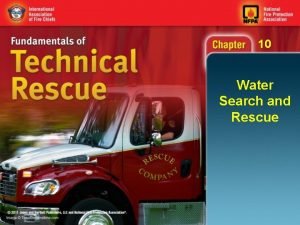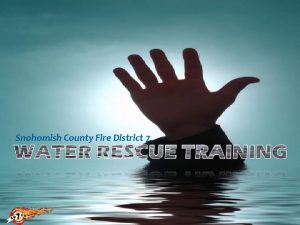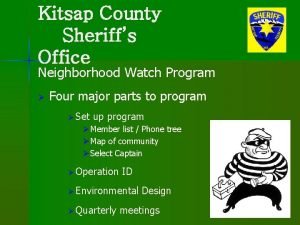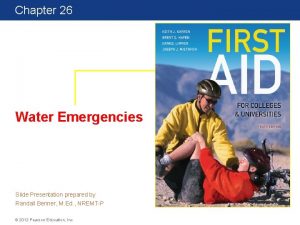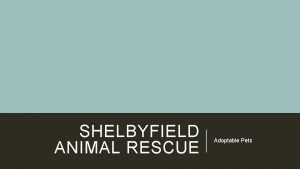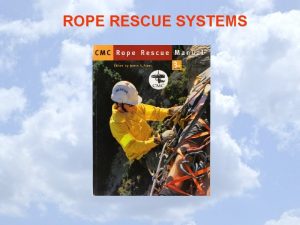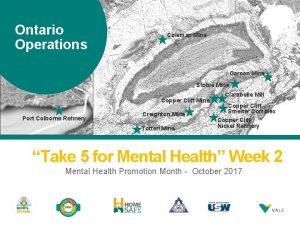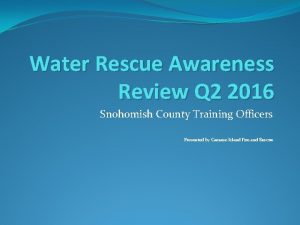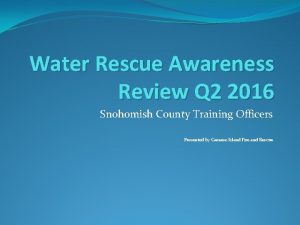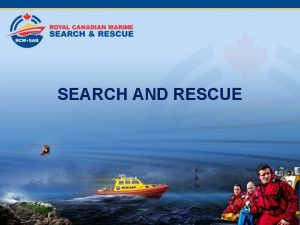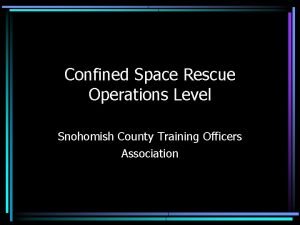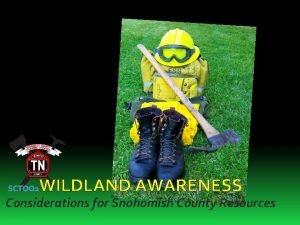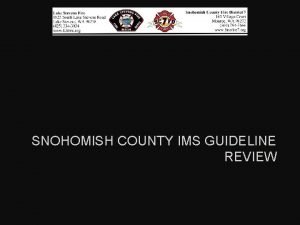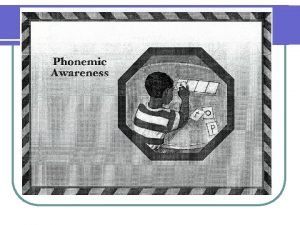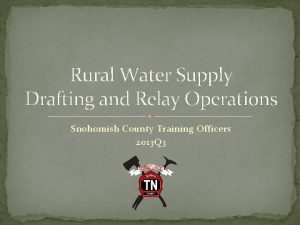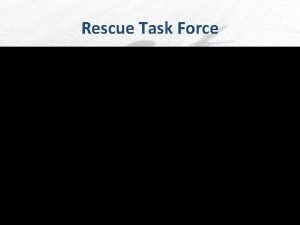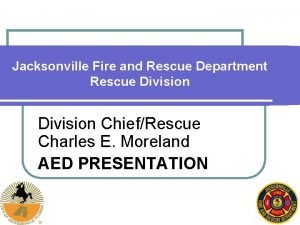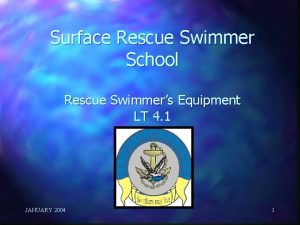Water Rescue Awareness Review Q 2 2018 Snohomish






















- Slides: 22

Water Rescue Awareness Review Q 2 2018 Snohomish County Training Officers

Water Rescue � At a minimum, all personnel in the fire service should be trained to the awareness level in water rescue. Most jurisdictions have some type of body of water. � In addition, most jurisdictions have the potential for flooding. This may include areas near rivers and lakes that flood slowly over a period of time, or a deadly ravine flash flood. If there is a water-related emergency, there is usually a request for the local fire department to respond. � Many water related incidents require resources and expertise beyond the normal capability of some fire departments, including divers, technicians, and teams trained to the operations or technician level. Many fire departments lack the necessary personal protective equipment and technical equipment to perform a full water rescue. � NFPA 1670 is the Standard of Operations and Training for Technical Rescue Incidents, and it recognizes four different water related disciplines at the operations and technician level. They are dive, ice, surf, and swift water.

Water Rescue Awareness � The Water Rescue Response for Awareness Level Trained Personnel : �When responding to a water rescue incident, assessment is the initial phase. �This starts at the time of dispatch, when you begin to gather information. When you arrive on the scene, begin your size-up. �What is the scope and magnitude of this incident? �What type of incident is this? �Are victims above or below the surface of the water?

Water Rescue Awareness � Evaluate the environmental factors involved - Those factors can change quickly with changing weather conditions. If the sun is about to set, you will need to consider lighting for the scene. Water levels and current changing drastically (flash flooding). Assess the hazards at the scene. As soon as possible, determine the location and number of victims. � As with any other rescue incident, do a risk/benefit analysis. Is this a rescue or a recovery? � All personnel operating on the scene need to know this information. Are there any access problems at the scene for responding companies? � The initial tasks that must be performed by a first responder to a water rescue incident require an overall level of control at the scene.

Water Rescue Awareness � Keeping control of all personnel - Also, it is necessary to control the bystanders. This is accomplished by establishing control zones. Use the assistance of police personnel to establish site security. Establish command use your incident command system. Accountability and safety of your personnel is paramount. Evaluate the resources you have available and those that will be needed. � Secure and interview any witnesses to the incident - If a victim, boat, plane, or vehicle has disappeared below the surface of the water, any witness will be extremely valuable. � Witnesses should be interviewed separately If witnesses are interviewed together, one could influence the other. Witnesses should be kept at the scene for as long as possible. If they do need to leave the scene, collect their personal information. They may need to be interviewed in the future.

Water Rescue Awareness � Try to establish a “last seen point”- You can triangulate the “last seen point” with more than one witness. A helpful technique in assisting the witness to describe the “last seen point” is to use a reference object. A reference object is the same size object (such as a boat or a person) that sank below the surface of the water. In order to create the reference object, put a person, boat, etc. in the water and have the witness visualize the “last seen point”. � At an ice incident - such as a person or a snowmobile through the ice, there is usually a well- defined hole in the ice. Upon arrival at the scene, rescuers may find that the victim is now below the surface of the water. That hole in the ice provides an excellent last seen point. Don’t destroy it! � Evaluate - any other physical evidence that might be found at the scene. This evidence could help determine the probability of a victim location. This type of evidence might include notes, clothes, footprints, etc. If a vehicle has entered the water, evidence such as tire tracks, debris, or oil and bubbles surfacing may be found.

Water Rescue Awareness � Identifying the Need for A Water Rescue Response Beyond The Awareness Level � The AHJ should have an emergency response system established for water related incidents. This is especially important if a single agency does not have all the necessary equipment and trained personnel. � This emergency response system should include the response of divers, ice divers, swift water technicians, etc. They should be trained to the operations or technician level. Police personnel and evidence technicians can be very valuable at many water rescue incidents. � Specialized equipment is often necessary. Such equipment includes diving equipment, sonar, boats, tow trucks, extrication equipment, dog teams, lift bag systems, etc.

Rescue Abilities of Your Company § AWARENESS personnel may § REACH – ladders, inflatable hose, pike poles, etc. § THROW – throw bags, line guns, flotation devices § That’s it- to ROW or GO you need specific certification training. SWR / RERS Certified personnel may § ROW – Use of inflatable kayaks on white water, use of rescue boats on class II rivers and lower, including Puget Sound, lakes, ponds, and flooded fields § GO – Swimming – Swift Water Rescue certified for river and/or Rapid Entry Rescue Swimmer certified only for static water surface and sub-surface

Water evaluation examples: § Overturned boat or missing swimmer in major river §Swift water rescue response with boats §SCFD #7 Boat 31 §Gold Bar Boat 54 §Hovercraft 94 §Swiftwater Team § Missing swimmer at lake §Rapid entry rescue swimmer §SCSO dive team §Rescue boat §SCSO or Navy Helo §Puget Sound §Coast Guard §Tulalip Boat 60 §North County Boat 97 §Sno 1 Marine 16 §Camano Fire Marine 102 or Marine 104 Moving water vs. Static water dictates what resource to request. If requesting a rescue boat include information as to where to launch.

Water Rescue Awareness �EMS should be included in the rescue response. It is not unreasonable to dispatch an ambulance for each victim and have an extra ambulance standing by for diver support. It may be appropriate to request air transport to stand by if there is a prolonged rescue and a need for the patient to be transported to a level I trauma center. This type of incident could cause first arriving personnel to tire quickly in a prolonged incident. Consider rehab personnel early on in the incident. Try to keep the incident operating in rescue mode. For personnel trained to the operations or technician level, a simple operational plan may include:

Certification Levels § Swift Water Rescue / SWR § Do you have these hazards in your response areas? § You need appropriate Swift Water Rescue training and proper thermal PPE. § Training includes in depth look into hydrology § Up stream and down stream § Spotters to be utilized. § Strong understanding of rope rescue is required to be successful

Certification Levels § Flood Rescue § You need appropriate PPE and proper Flood Rescue training § You must have knowledge of and possession of map, compass, GPS, strobes, lights, appropriate water resistant radios, PFDs for the patients, first aid considerations for non-ambulatory patient’s, etc. § Watch your crew for signs of hypothermia and sickness during prolonged incidents. § Have entry times and exit times to monitor your crews for exposure (flood season)

Certification Levels § Surface Water and Ice Rescue § You need appropriate PPE and proper Water Rescue training to complete a surface rescue. § A Surface swim to reach your patient is different in every type of water you can imagine. Special training is available as the inherent risks are different for each. § Bottom Line, Benefit must still out-weigh the risk § River – Flood – Lake – Surf – Ice – Pool – Big Water

Certification Levels § Lake Rescue using the Rapid Entry Rescue Swimmer Program / RERS § You need appropriate PPE and training / certification § You must demonstrate Aquatic Stability and Self Rescue § Understand Surface rescue vs. Sub-surface rescue. § Using a boat vs. swimming out. What can your crew do? Do you know? Find out. § Rescue Mode? For cold water- you have 60 minutes from on-scene time Swimmer dives down 20’ to vehicle during training to pull victim

Water Rescue Awareness Environmental Hazards � Environmental hazards can include temperature extremes. Extreme cold causes hypothermia, frostnip, and frostbite. When rescuers are cold, that can affect their ability to think clearly or perform simple motor skills. Cold temperatures can also cause equipment failures, including boat motors, diving regulators, etc. In hot temperatures, rescuers can easily become exhausted, overheated, and dehydrated. Personal protective equipment, designed to keep the wearer from sinking in the water, can also cause overheating on a hot day. Weather, such as snow, rain, and fog, adds another hazard to the incident. High winds often produce waves large enough to keep rescue teams from operating on or near the water. As soon as rescue team members get wet, they are much more prone to become hypothermic. � Body heat is lost to still water 25 times as fast as to still air of the same temperature. � The aquatic environment can add hazards to the scene. This can include aquatic life, animal life, and insects. Plant life, like seaweed, can reduce or impair visibility. It can also become an entanglement hazard. The water quality in itself can be a hazard. Heavy sediment or silt can result in zero visibility. Some aquatic environments contain harmful bacterial or viral biohazards.

Water Rescue Awareness General Hazards � Utilities such as electrical, gas, sanitary, and communications can present a hazard at the water rescue incident. If this is the case, requesting assistance from the responsible utility company, early into the incident, can prove to be very valuable, if not life saving. � Various hazardous materials can be present at water rescue incidents. Operating in this environment will require the assistance from a qualified hazardous materials team. They should be prepared to advise on the proper personal protective equipment and decontamination procedures/guidelines. Personal hazards at a water rescue incident can include simple trips and falls on uneven, steep, and slippery terrain, which are typically found at the water’s edge. The presence of such hazards often requires the assistance of rope rescue technicians. They can rig systems to assist personnel and equipment up and down steep, slippery terrain.

Water Rescue Awareness Personal Protective Equipment During Water Rescue Incidents � Firefighting helmets, boots, and turnout gear are not typically appropriate personal protective gear for water rescue incidents. If you want to perform water rescues, wearing the proper thermal protection, with buoyancy, is essential. Common outerwear for performing water rescues might include cold-water rescue suits, wet suits, and dry suits. All personnel working at the scene, in a boat, near the water, or as a line tender, should wear a properly fitted PFD (personal flotation device). Having a PFD hang around your neck, without it being secured, will not do you any good if you fall into the water. Secure it properly. Support personnel who find it necessary to wear their turnout coat for warmth, will often wear their PFD under their coat. Equipment you might consider adding to your PFD could include a whistle and a rescue knife. Taglines, lifelines, helmets, and gloves are some of the other pieces of PPE items you may find necessary for a water rescue

Water Rescue Communications* Whistle Signals: § One Blast – Stop or Attention § Two Blast – Watch/look at me or direction indicated § Three Blast Repeated – Emergency, help. *SCFD #7 Procedure– Check your agencies procedure

Water Rescue Communications* Hand Signals: �In the Water �One hand extended above the head and/or mask positioned on forehead – NEED HELP �One arm up with two taps on the head – OK �On the Shore �One arm up with hand on the head – Are you ok? �Two hands extended above the head, then pointing in a direction – move, swim in the direction indicated. *SCFD #7 Procedure– Check your agency’s procedure

Water Rescue Communications* Tether Rope Signals (OATH): �One Tug – Ok, can be to ask and to answer �Two Tugs – Advancing, give me rope �Three Tugs – Take up, I’m coming back �Four Tugs – Help, send stand-by Rescue Swimmer *SCFD #7 Procedure– Check your agency’s procedure

Shore Based Rescue Technique � The fittings and tools you need to inflate a fire hose with air: a female 2 ½" port cap, a 2 ½" male port cap with a pneumatic fitting (airbag hose compatible) and a petcock valve to allow the hose to deflate. The Hose Inflation Kit • 1 female 2 ½" port cap • 1 male 2 ½" port cap with a pneumatic fitting and petcock valve • Two 2 ½" spanner wrenches • 1 airbag regulator with one air line • 1 SCBA air cylinder • 1 toss ring with a minimum of 12 feet of 1" webbing • Two 2 ½" spanner wrenches � Hose Inflation Technique Drill How long does it take a two-person crew to deploy 150 feet of 2 ½" fire hose filled with air? How long does it take a three-person crew? Tip: With pre-assigned position assignments, you can greatly reduce deployment time. To perform this drill, break up into two-person crews, then record how long it takes each crew to deploy the line and gather it up when finished. The steps are: Pull 150 feet of a pre-connected 2 ½" handline, remove the nozzle, install the female cap, grab the spanners and stretch the line to the incident. After tightening the cap with the spanners, work your way back to the end of the hose where your partner should have left the airbag regulator and other equipment. You can now hook up the pneumatic fittings and fill the hose with air. Your partner should then bring the toss-ring with webbing to the other end and secure it to the fire hose. How much air is enough? The hose should not depress when you step on it. Repeat with three-person crews. Compare the times from the first rotation with the times from the fourth or final rotation to see how much you’ve improved. If you’re having trouble, make position assignments and see whether that helps reduce your time. Master the above skills and you’ll be ready to perform shore-based rescue techniques in an organized manner.

Review �The key to successful water rescue is requesting resources early �Identifying the last know location �Determining Rescue vs Recovery mode �Not committing untrained personnel to the hazard area. �Establish control zones early and maintain them as the incident changes
 Reach throw wade row swim tow
Reach throw wade row swim tow Water and water and water water
Water and water and water water Cvs privacy awareness and hipaa privacy training
Cvs privacy awareness and hipaa privacy training Coordinated entry snohomish county
Coordinated entry snohomish county Snohomish naturopathic clinic
Snohomish naturopathic clinic Snohomish county south precinct
Snohomish county south precinct Snohomish county fire district 7
Snohomish county fire district 7 Kitsap crime watch
Kitsap crime watch Types of drowning
Types of drowning Dada la siguiente secuencia rusia 2018 rusia 2018
Dada la siguiente secuencia rusia 2018 rusia 2018 Biology semester 1 review 2018
Biology semester 1 review 2018 Chapter review motion part a vocabulary review answer key
Chapter review motion part a vocabulary review answer key Uncontrollable spending ap gov
Uncontrollable spending ap gov Narrative review vs systematic review
Narrative review vs systematic review Search strategy example
Search strategy example Narrative review vs systematic review
Narrative review vs systematic review Boulder food rescue
Boulder food rescue Shelbyfield
Shelbyfield Archer check rope rescue
Archer check rope rescue Surface rescue swimmer school
Surface rescue swimmer school Rescue deck
Rescue deck Search and rescue radar transponder
Search and rescue radar transponder Mine rescue 18-6
Mine rescue 18-6
